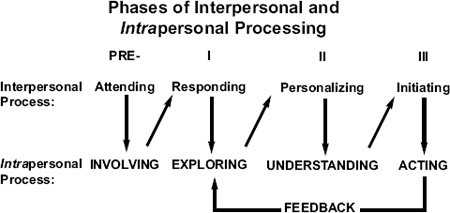HELPEE ACTING/
HELPER INITIATING |
| Helper: |
“So Floyd, you want other people to see you as an individual. And Tom, you want Floyd to see you as an individual. How could you each tell if you were reaching those goals?” |
Defining the Goals |
| Floyd: |
“A good indication for me would be if I could get on the board of the Literary Magazine without having to be the ‘racial reporter.’” |
|
| Tom: |
“I’d just like to get rid of all my behaviors that Floyd feels are racist, so we can get beyond the color of our skins.” |
|
| Helper: |
“O.K. Those sound like pretty realistic goals. Let’s work on Floyd’s program first. What might a first step be?” |
Initiating First Step |
| Floyd: |
“Well, I could make out a list of things I’d like to do on the magazine.” |
|
| Helper: |
“That’s great! We call those values. If those are your values, what would the magazine’s values be?” |
Initiating Intermediate Steps |
| Floyd: |
“That would be what the magazine would want a writer to do.” |
|
| Helper: |
“Good! We call those requirements. So what do we do next?” |
Initiating Intermediate Steps |
| Floyd: |
“Well, obviously we’ve got to match up my values and their requirements—sort of like matching up columns A and B.” |
|
| Helper: |
“So where they match, you …” |
Initiating Final Steps |
| Floyd: |
“I’ve got to show them what I can do for them—It’s sort of like advertising yourself.” |
|
| Helper: |
“That’s nice and clean for you. Getting on the writing staff of the magazine is your goal. Your first step is values. Your intermediary steps are requirements and matching. Your final step is promoting or advertising yourself.” |
Summarizing Steps |
| Floyd: |
“I can do that!” |
` |
| Helper: |
You’re confident in your program. It’s sort of like testing yourself out.” |
Personalizing Meaning |
| Floyd: |
“At least I’ll find out if the problem is in them or in me.” |
|
| Tom: |
“Or somewhere in between.” |
|
| Helper: |
“That’s where you think it might be with you and Floyd—somewhere in between you.’’ |
|
| Tom: |
“Well, if I get the drift of your program, I might operate that same way: |
Personalizing Meaning |
| |
1. Set a goal of getting rid of racist attitudes and behaviors. |
|
| |
2. Do the first step of getting Floyd to make a list of my behaviors that he experi ences as racist. |
|
| |
3. Do the intermediary steps of making a list of what I can handle and what I can’t. |
|
| |
4. Get help from someone else for what I can’t handle.” |
Initiating Steps |
| Floyd: |
“You mean I won’t have to hear the term “you people” anymore?” |
|
| Helper: |
“You really have it together now. That’s a program that comes from the heart—out of your real motivation to change, Tom.” |
Personalizing Meaning |
| Floyd: |
“I got to give you that, man!” |
|
| Helper: |
“You’re both pretty excited about the possibilities.” |
Personalizing Feelings |
| Tom: |
“And eager to get started!” |
|
| Floyd: |
“Maybe we won’t have to have a revolution every generation.” |
|
| Helper: |
“You’re feeling hopeful because you’re beginning to see how you can get there from here!” |
Personalizing Feelings |

